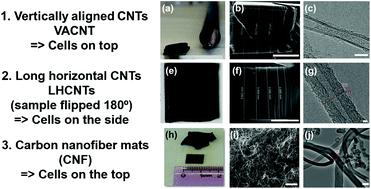Our official English website, www.x-mol.net, welcomes your
feedback! (Note: you will need to create a separate account there.)
Carbon nanostructures as a scaffold for human embryonic stem cell differentiation toward photoreceptor precursors.
Nanoscale ( IF 5.8 ) Pub Date : 2020-08-27 , DOI: 10.1039/d0nr02256j Yoav Chemla 1 , Efrat Shawat Avraham , Amos Markus , Eti Teblum , Aviad Slotky , Yulia Kostikov , Nairouz Farah , Madina Telkhozhayeva , Irit Shoval , Gilbert Daniel Nessim , Yossi Mandel
Nanoscale ( IF 5.8 ) Pub Date : 2020-08-27 , DOI: 10.1039/d0nr02256j Yoav Chemla 1 , Efrat Shawat Avraham , Amos Markus , Eti Teblum , Aviad Slotky , Yulia Kostikov , Nairouz Farah , Madina Telkhozhayeva , Irit Shoval , Gilbert Daniel Nessim , Yossi Mandel
Affiliation

|
Carbon nanomaterials have been introduced as a scaffold for various biological applications due to their unique physical and electrical properties. Here we studied carbon nanotubes (CNTs) and carbon nanofibers (CNFs) as scaffold materials for the differentiation of human embryonic stem cells (hESCs) towards photoreceptor precursor cells (PRPs). We report on their cytoxicity, their effect on cell morphology, cell-surface interface and the differentiation process. To this end, hESCs were differentiated into PRPs on carbon nanofibers (CNFs), long horizontal CNTs (LHCNTs), vertically aligned CNTs (VACNTs) or glass (control) surfaces. The differentiated cells were investigated by immunohistochemistry, fluorescence imaging and electron microscopy. Our results revealed that the investigated nanomaterials were not cytotoxic to the cells during the differentiation process. The surface interface effect on the cells was apparent, affecting cell directionality, migration and morphology. Interestingly, cell fate was not dependent on the substrate type, as inferred from the similar dynamics of the loss of pluripotency and the comparable expression levels of the photoreceptor marker Crx for all investigated substrates. These results are important for better understanding the effect of nanomaterial surface interaction with differentiating neural cells in general, and for future use of these materials as scaffolds for differentiating photoreceptors for vision restoration in particular.
中文翻译:

碳纳米结构作为人类胚胎干细胞向感光细胞前体分化的支架。
碳纳米材料由于其独特的物理和电学性质已被引入各种生物应用的支架。在这里,我们研究了碳纳米管(CNTs)和碳纳米纤维(CNFs)作为支架材料,用于人类胚胎干细胞(hESCs)向感光前体细胞(PRPs)的分化。我们报告了它们的细胞毒性,它们对细胞形态,细胞表面界面和分化过程的影响。为此,hESCs可以分为碳纳米纤维(CNF),长水平CNT(LHCNT),垂直排列的CNT(VACNT)或玻璃(对照)表面上的PRP。通过免疫组织化学,荧光成像和电子显微镜研究分化的细胞。我们的结果表明,所研究的纳米材料在分化过程中对细胞没有细胞毒性。表面对细胞的影响是显而易见的,影响细胞的方向性,迁移和形态。有趣的是,细胞命运并不取决于底物类型,这是由所有研究底物的多能性损失的相似动力学和感光标记Crx的可比表达水平得出的。这些结果对于总体上更好地理解纳米材料表面与分化神经细胞的相互作用的重要性,以及对于这些材料作为未来用于分化感光体(特别是用于视力恢复)的支架的未来用途而言,都是重要的。迁移和形态。有趣的是,细胞命运并不取决于底物类型,这是由所有研究底物的多能性损失的相似动态和感光受体Crx的可比表达水平得出的。这些结果对于总体上更好地理解纳米材料表面与分化神经细胞的相互作用的重要性,以及对于这些材料作为未来用于分化感光体(特别是用于视力恢复)的支架的未来使用而言,都是重要的。迁移和形态。有趣的是,细胞命运并不取决于底物类型,这是由所有研究底物的多能性损失的相似动态和感光受体Crx的可比表达水平得出的。这些结果对于总体上更好地理解纳米材料表面与分化神经细胞的相互作用的重要性,以及对于这些材料作为未来用于分化感光体(特别是用于视力恢复)的支架的未来用途而言,都是重要的。
更新日期:2020-09-24
中文翻译:

碳纳米结构作为人类胚胎干细胞向感光细胞前体分化的支架。
碳纳米材料由于其独特的物理和电学性质已被引入各种生物应用的支架。在这里,我们研究了碳纳米管(CNTs)和碳纳米纤维(CNFs)作为支架材料,用于人类胚胎干细胞(hESCs)向感光前体细胞(PRPs)的分化。我们报告了它们的细胞毒性,它们对细胞形态,细胞表面界面和分化过程的影响。为此,hESCs可以分为碳纳米纤维(CNF),长水平CNT(LHCNT),垂直排列的CNT(VACNT)或玻璃(对照)表面上的PRP。通过免疫组织化学,荧光成像和电子显微镜研究分化的细胞。我们的结果表明,所研究的纳米材料在分化过程中对细胞没有细胞毒性。表面对细胞的影响是显而易见的,影响细胞的方向性,迁移和形态。有趣的是,细胞命运并不取决于底物类型,这是由所有研究底物的多能性损失的相似动力学和感光标记Crx的可比表达水平得出的。这些结果对于总体上更好地理解纳米材料表面与分化神经细胞的相互作用的重要性,以及对于这些材料作为未来用于分化感光体(特别是用于视力恢复)的支架的未来用途而言,都是重要的。迁移和形态。有趣的是,细胞命运并不取决于底物类型,这是由所有研究底物的多能性损失的相似动态和感光受体Crx的可比表达水平得出的。这些结果对于总体上更好地理解纳米材料表面与分化神经细胞的相互作用的重要性,以及对于这些材料作为未来用于分化感光体(特别是用于视力恢复)的支架的未来使用而言,都是重要的。迁移和形态。有趣的是,细胞命运并不取决于底物类型,这是由所有研究底物的多能性损失的相似动态和感光受体Crx的可比表达水平得出的。这些结果对于总体上更好地理解纳米材料表面与分化神经细胞的相互作用的重要性,以及对于这些材料作为未来用于分化感光体(特别是用于视力恢复)的支架的未来用途而言,都是重要的。











































 京公网安备 11010802027423号
京公网安备 11010802027423号